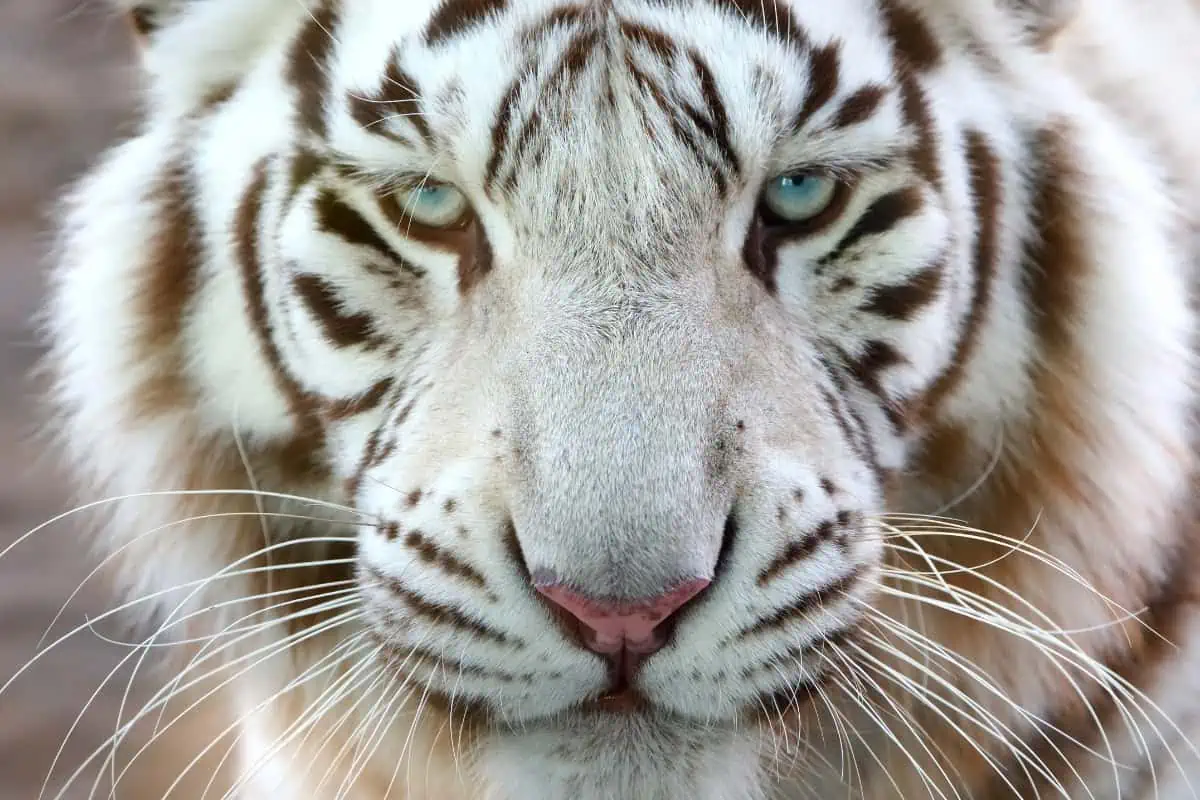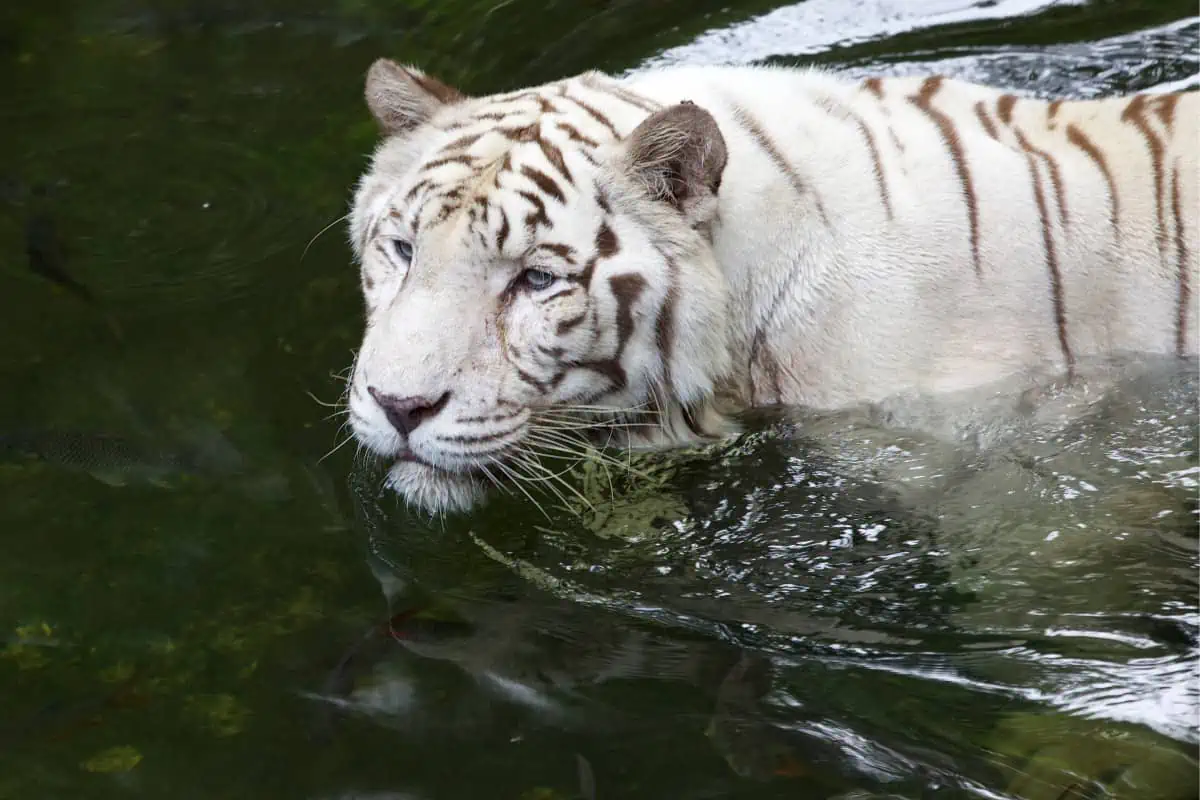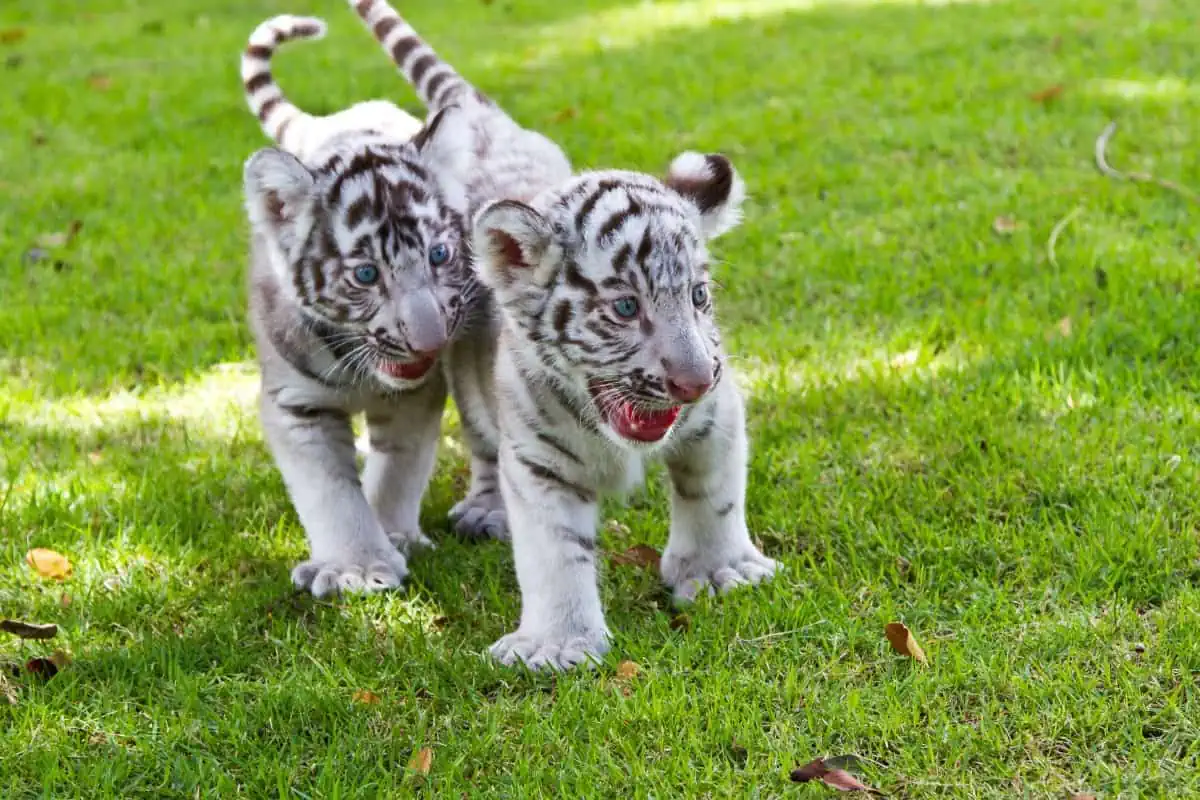White tigers are among the most captivating big cats on Earth. Their striking white fur, mesmerizing blue eyes, immense size, and powerful build demand attention and leave a lasting impression.
As members of the Bengal tiger species, these extraordinary creatures have a unique story, full of intrigue, beauty, and controversy.
In this article, we will unveil ten fascinating facts about the mystical white tiger, exploring their characteristics, challenges, and the role they play in wildlife conservation.
10 White Tiger Facts:

1. White Tigers are not a Separate Species
Contrary to popular belief, white tigers are not a separate species or subspecies. Instead, they are Bengal tigers with a genetic mutation that results in their distinct coloration.
This mutation, which affects pigment production, occurs in approximately 1 out of every 10,000 births. Although this rarity makes white tigers special, it is essential to remember that they are, in essence, Bengal tigers with a unique appearance.
This understanding helps dispel misconceptions and encourages the public to value all species members equally.
| Feature | White Tiger | Bengal Tiger (Typical Coloring) |
|---|---|---|
| Species | Panthera tigris tigris (Bengal tiger) | Panthera tigris tigris (Bengal tiger) |
| Coloration | White fur with black/brown stripes | Orange fur with black stripes |
| Cause of Coloration | Leucism (reduced pigmentation) | Normal pigmentation |
| Eye Color | Blue | Yellow or green |
| Rarity | 1 in 10,000 natural births | Common |
| Health Issues | Crossed eyes (natural), inbreeding issues | Fewer health issues associated with color |
| Sunbathing | More likely to bask under the sun | Less time spent sunbathing |
| Affinity for Water | Especially fond of swimming | Also enjoys swimming |
2. Inbreeding has Increased the White Tiger Population
While white tigers were once incredibly rare, inbreeding has caused their numbers to rise significantly.
Some may argue that more white tigers are good, but the reality is far more complex. The inbreeding responsible for increasing the white tiger population comes with many health complications and ethical concerns.
Unscrupulous breeders continue to produce white tigers, despite the risks to the animals’ well-being. The perceived value of white tigers remains high, thanks to their captivating beauty and the marketing tactics of those involved in the wildlife trade.
The Association of Zoos & Aquariums (AZA) is working to combat this issue by campaigning against inbreeding and advocating for responsible conservation practices.
3. Inbred White Tigers Face Numerous Health Issues
Inbred white tigers suffer from various health problems due to the deterioration of their genetic material.
Some of the issues these animals face include physical deformities, cardiovascular problems, crossed eyes, misaligned jaws, and cleft palates.
Aside from a tendency for crossed eyes, it is essential to note that these defects are not present in naturally-born white tigers.
As awareness of these health complications increases, it is vital that efforts are made to promote responsible breeding and conservation practices.
By prioritizing the welfare of white tigers and their Bengal tiger counterparts, we can work towards a brighter future for these magnificent animals.
4. White Tigers Have a Unique Reaction to Anesthesia
Anesthesia poses risks to all animals, but white tigers are particularly vulnerable. When emerging from sedation, these big cats often experience a relapse.
This unique reaction is attributed to their inability to produce normal amounts of tyrosinase, an enzyme involved in melanin production.
As a result, extra caution and care must be taken when administering anesthesia to white tigers to ensure their safety during medical procedures.
5. Leucism, Not Albinism, Causes Their White Fur
Although often mistaken for albinism, the white tigers’ white fur is actually caused by leucism.
This genetic condition reduces pigmentation, giving the animals their iconic white fur. However, unlike albinism, leucism still allows for the presence of some pigments, such as eumelanin, which gives color to their eyes and stripes.
This distinction is essential to understanding the true nature of the white tiger’s appearance.
6. White Tigers Enjoy Sunbathing More Than Other Tigers
White tigers are known to spend more time basking under the sun than their darker-hued counterparts.
Their unique fur coloration may help them stay cooler, allowing them to enjoy the warmth for longer.
Witnessing a white tiger basking in sunlight is a truly majestic sight, contributing to the association of these animals with mysticism and spirituality.
7. A Fondness for Water Sets Them Apart
All tigers are known for their affinity for water, but white tigers are especially fond of swimming.
These captivating creatures can often be found basking in the sun or refreshingly dipping in the water.
This love for water adds another dimension to the allure of white tigers and further distinguishes them from other big cats.

8. White Tigers are Popular Crowd Pleasers
Despite the controversies surrounding their breeding, white tigers remain immensely popular in various settings, from zoos to performing animal shows.
Their stunning beauty alone is enough to captivate audiences, even when they’re simply standing or lying down.
Additionally, white tigers are naturally curious creatures, often eager to explore and play, adding to their charm as crowd entertainers.
9. White Tigers Struggle to Survive in the Wild
The last known sighting of a wild white tiger was in 1958. Since then, no confirmed reports of white tigers have been in their natural habitat.
This rarity can be attributed to the 1 in 10,000 chance of a white tiger being born naturally and their difficulty in catching prey due to their conspicuous coloring.
Another, more somber reason for their scarcity in the wild is the tendency for mother tigers to kill white cubs in their litter. These tiger cubs are perceived as aberrations that could endanger the more typically colored offspring.
Fortunately, around 200 white tigers live in captivity, with more in the care of private owners.

10. White Tigers Symbolize Spirituality, Mysticism, and Greed
Due to their otherworldly appearance, white tigers are often seen as symbols of spirituality, cleanliness, and mysticism. However, they also represent humanity’s greed.
Overbreeding white tigers for profit has led to many ethical and welfare concerns. Zoos and other establishments often exploit their crowd-drawing abilities while breeders capitalize on the high-profit margins associated with these majestic creatures.
The demand for white tigers persists despite widespread campaigns against the wildlife trade.
Final Thoughts
The white tiger serves as a powerful animal ambassador, using its captivating beauty to draw attention to the plight of tigers worldwide.
By harnessing this allure for educational purposes, the white tiger could play a vital role in saving its species from the brink of extinction. The AZA’s efforts to ban inbreeding are a step in the right direction, but more proactive measures are needed to protect these magnificent creatures.
Through continued education and awareness, we can work together to minimize the damage inflicted on white tigers and the entire species, ensuring their survival for generations.
